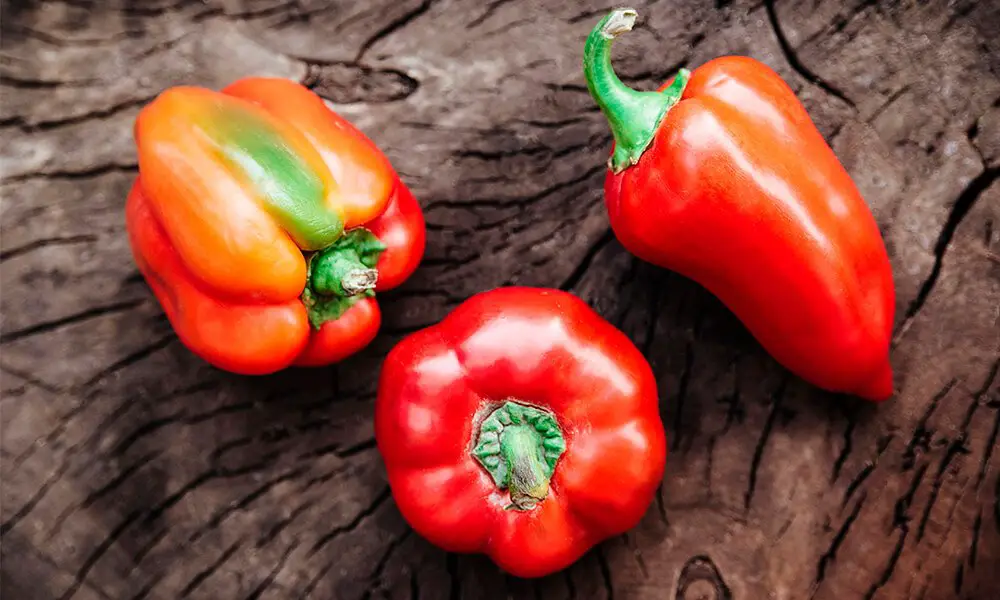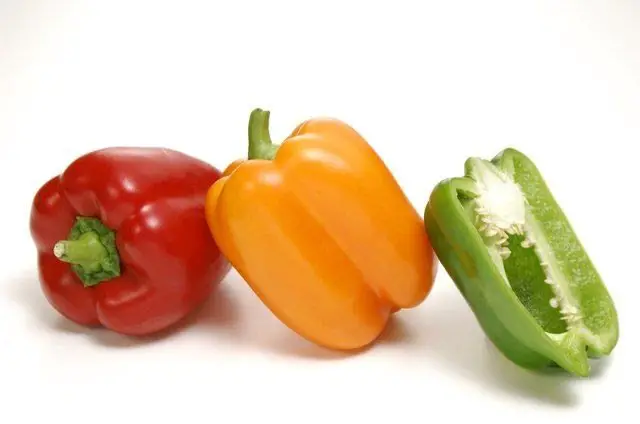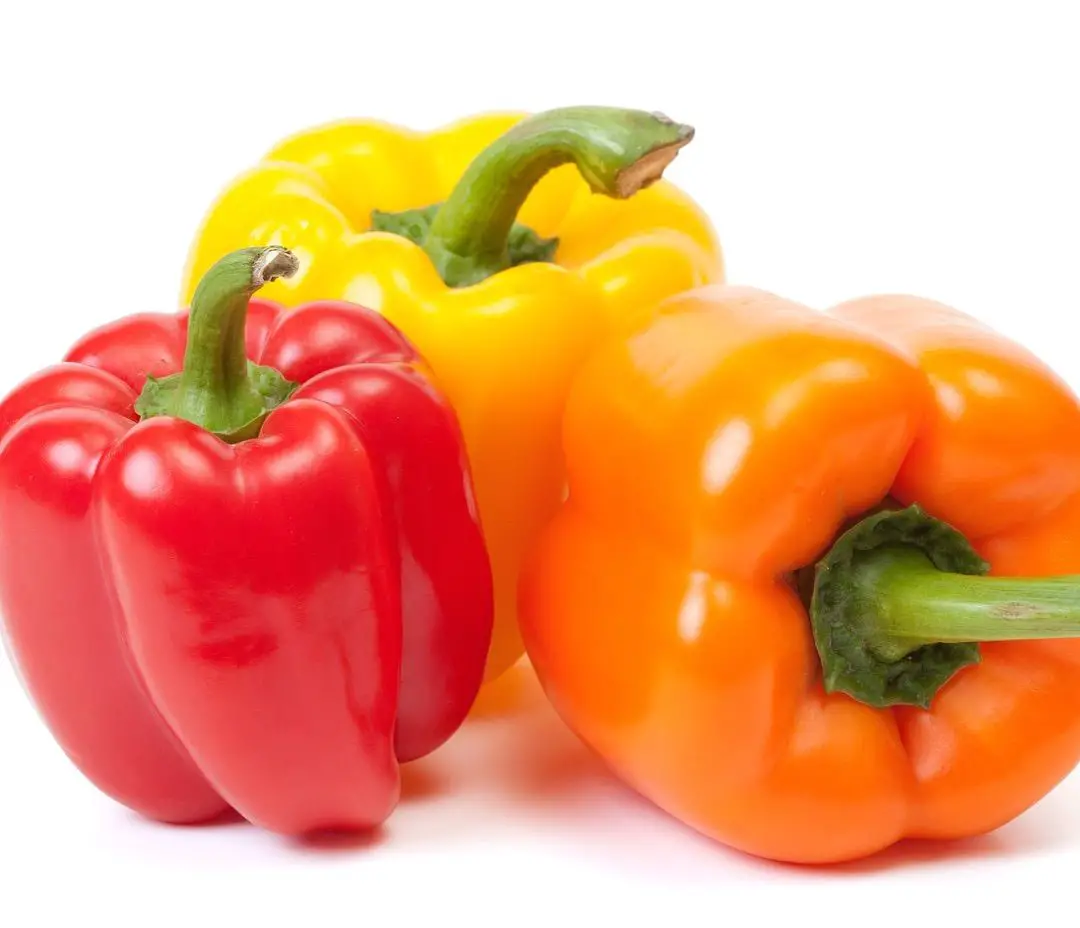Bell Peppers Contain A Lot Of Vitamin C
A bell pepper contains a lot of vitamin C and is rightly called a vitamin bomb, says market analyst Van den Berg.
“Paprika contains three times as much vitamin C as an orange.”
For fans of the red pepper: according to the Nutrition Center, it contains the most vitamins with 180 milligrams each.
The green contains half less.
“A green pepper contains less vitamin C because it is still a young, not fully-grown pepper,” says food blogger Van Dijke.
According to Van den Berg, it is logical that we started eating more red peppers in corona year 2020.
“People paid more attention to their health. But it is also because we started cooking more at home. Young people in particular did this more often, they ate out a lot before the crisis. The consumption of bell peppers increased by 20 percent in that period. “
Keywords:
Do Bell Peppers Help You Lose Weight
Bell peppers contain 31 calories per 100 grams. 24.3 of these calories come from carbohydrates . This would be a good reason to include bell peppers in your diet. The amount of calories in bell peppers is low compared to many other vegetables to help you lose weight, helping you feel fuller without adding too many calories to your diet. This can help you eat fewer high-calorie foods.
Consumption of enough vitamins and minerals is essential for both short-term health and weight loss. Bell peppers can help you reach your daily vitamin and mineral goals to some extent, but you will also need other foods. This means that it is good to eat bell peppers daily, but you will also need a balanced diet.
Content Per Typical Serving Size 1 Pepper
To give 100% of the RDA, 100.0 servings of the typical serving size 1 pepper give the complete RDA. In terms of the gram weight and total content for this serving the Calories content is 47.77 kcal, the Protein content is 2.02 g, the Fat content is 1.39 g and the Carbohydrate content is 8.74 g. The percentages are shown below in the vitamin c chart, for the typical serving of vitamin c and the related and important nutritional values.
Don’t Miss: What Vitamins Make Your Immune System Stronger
Help With Premenstrual Syndrome
Premenstrual syndrome is womens number one nemesis. PMS is experienced when the menstrual period is approaching. PMS affects women emotionally and physically that can ruin our productivity. To help you with this, Yellow Bell Pepper is best as the high level of folate, and B6 Vitamins can help produce hormones, thus, also helps you with premenstrual syndrome.
Read Also: Health Benefits of Coconut Oil
Bell Peppers: Nutrition Facts Benefits And Research

Last Updated on February 16, 2021 by Michael Joseph
Bell peppers are delicious, crunchy, and full of flavor.
While we think of them as vegetables, bell peppers are technically a fruit that belongs to the Capsicum annuum species of plants .
Nutritionally, bell peppers provide a substantial vitamin C source, a wide range of nutrients, and they may have some interesting benefits.
This article takes an in-depth look at bell peppers and their nutritional values, potential health benefits, and how to use them.
Also Check: What Does Vitamin C Do To The Face
Is It Good To Eat Peppers Every Day
If you like peppers, enjoy them as much as you likeyou can eat them every day or even at every meal, says Rizzo.
However, its important to eat everything in moderation. According to the USDA, one serving of a raw bell pepper is 3.5 ounces , which is about half of a bell pepper.
Bottom line: If you already enjoy peppers in your diet, they are a great source of hydration and vital nutrients. And, if you dont eat them already, there are many different types of peppers you can tryand likely find one that you like. Remember, even though they are healthy, its important to eat everything in moderation.
Foods That Have More Vitamin C Than An Orange
Vitamin C is a powerful antioxidant thats readily available in tons of fruits and veggies . And while it may not actually help cure a cold, as is commonly thought to be the case, Lindsey Pine, M.S., R.D., owner of Tasty Balance Nutrition, says it can boost your immune system and help your body fight infection. Its also a great vitamin to load up on after a workout because its anti-inflammatory properties can help .
So how much should you try to have on a daily basis? Pine explains that you can safely consume up to 2,000 mg of vitamin C, but you definitely dont need that much to reap the benefitsin fact, adult women only need about 75 mg a day, she says. Filling this quota is incredibly easy. Just one orange has about 100 mg of vitamin C, which is 130 percent of that daily recommended intake.
But oranges arent the only source of this important nutrient. Whether you arent a fan of that classic fruit, or are just looking to mix up your diet, these 10 foods have more than enough vitamin C to satisfy the daily recommendationno citrus in sight.
Don’t Miss: How Do I Know What Vitamins To Take
Foods With More Vitamin C Than Oranges
Fill up on these vitamin-packed superfoods.
Oct. 31, 2013 — intro: If you chug a glass of orange juice every time you start sniffling, you may be onto something. Though studies show that consuming vitamin C can’t actually prevent colds, loading up on the nutrient may help slightly shorten the length of time you’re sick and reduce the severity of your symptoms.
But despite their reputation for being loaded with vitamin C, the 69.7 mg that a medium orange provides is actually less than many other common fruits and veggies. To pack the ultimate vitamin C punch, fill up on these 12 superfoods.
quicklist: 1category: Foods With More Vitamin C Than Orangestitle: Chili peppersurl: text: A half-cup of chopped or diced chili peppers delivers 107.8 mg of vitamin C. Plus, researchers from the University of Buffalo found that capsaicin, the compound that makes chili peppers hot, may help relieve joint and muscle pain.
quicklist: 2category: Foods With More Vitamin C Than Orangestitle: Red bell pepperurl: text: A cup of chopped red bell pepper contains nearly three times more vitamin C than an orange190 mg. Red peppers are also a great source of vitamin A, which promotes eye health.
The Truth About Common Vision Myths
Getting a Cold? Do This Right Now
10 Ways to Soothe a Sore Throat
What Is The Recommended Daily Allowance Of Vitamin C
Its pretty much impossible to overdose on vitamin C, and its almost equally difficult to be vitamin C deficient, unless you live somewhere with little access to fruits and vegetables. Moore says at the very minimum your body needs 10 mg of vitamin C per day, but the recommended daily allowance will vary depending on age, gender, age, and lifestyle choices like smoking.
According to an earlier report published by the U.S. Food and Nutrition Board, infants up to 6 months old should get at least 40 mg, children between 4 and 8 years should get 25 mg, teens between ages 14 and 18 should have around 75 mg for boys and 65 mg for girls, and among people ages 19 and older, the RDA is 90 mg for men and 75 mg for women. Some people need extra vitamin C, like smokers, who should get an additional 35 mg per day. Pregnant women need 85 mg, and lactating women require 120 mg of vitamin C.
As a reminder, Dr. Wald says the RDA is the minimum amount needed to prevent vitamin C deficiency, and isnt necessarily representative of the ideal vitamin C value each person needs.
RELATED: Can Vitamin C Cure a Spring Cold?
Also Check: Can You Buy Vitamins With Fsa
Food Facts: So Much Vitamin C Contains A Bell Pepper
2021-07-09T10:14:27.691Z
The Dutch like to eat tomatoes, cucumbers and peppers. Onions, carrots and stir-fried vegetables are also widely sold in our supermarkets, according to a top ten by research agency GfK. But what do we actually not know about the vegetables we eat most often? This time all about the peppers.
The Dutch like to eat tomatoes, cucumbers and peppers.
Onions, carrots and stir-fried vegetables are also widely sold in our supermarkets, according to a top ten by research agency GfK.
But what do we actually not know about the vegetables we eat most often?
This time all about the peppers.
In recent years, we have started growing more and more peppers in the Netherlands.
But the vegetable variety of Central American origin only started to gain traction in our country in the 1960s, the start of cultivation on our own soil.
Until twenty years ago, peppers were not eaten very often.
We now spend the most money of all vegetables – except for tomatoes.
In 2000, 285 million kilos of peppers were grown in the Netherlands, in 2020 that was already 430 million kilos.
Wilco van den Berg, market analyst at GroentenFruit Huis, sees peppers becoming more popular every year.
In 2000, 285 million kilos of peppers were grown in the Netherlands, in 2020 that was already 430 million kilos.
“An increase of 50 percent. Last year was another record year.”
But we don’t all eat the peppers grown in the Netherlands ourselves.
Bell Peppers Color Differences
The type of peppers and the harvest period influence their color, taste, and aroma. Peppers go through specific processes during the ripening period, during which their chemical composition changes.
Green peppers contain a much higher amount of chlorophyll and have a fresh smell due to aldehydes. The orange ones have lutein, violaxanthin and beta-carotene, chemical compounds responsible for the specific color, the same as for carrots. Red pepper produces more E-2-hexenal and E-2-hexanol, which also gives it a sweet fruity aroma. Carotenoid pigments in red pepper include capsanthin and capsorubin.
Here is the nutritional composition of bell peppers by color:
You May Like: What Vitamins Improve Egg Quality
Determination Of Vitamin C In Various Colours Of Bell Pepper By Titration Method
Nerdy Nerdy
Abstract
Keywords
Full Text:
References
Al Majidi, M.I.H., and Al Qubury, H.Y. 2016. Determination of Vitamin C Contents in Various Fruit and Vegetable by UV Spectrophotometry and Titration Methods. Journal of Chemical and Pharmaceutical Sciences 9, 2972-2974.
Bekele, D.A., and Geleta, G.S. 2015. Iodometric Determination of the Ascorbic Acid content of some Fruits consumed in Jimma Town Community in Ethiopia. Research Journal of Chemical Sciences 5, 60-63.
Bieniasz, M., Dziedzic, E., and Kaczmarczyk, E. 2017. The Effect of Storage and Processing on Vitamin C Content in Japanese Quince Fruit. Folia Horticulturae 29, 83-93.
Counsel, J.N. and Hornig, D.H. 1981. Vitamin C. London and New Jersey: Applied Science Publishers.
Djokovi, G.A., Pavlovi, R., Mladenovi, J., and Djuri, M. 2011. Vitamin C Content in Different Types of Lettuce Varieties. Acta Agriculturae Serbica 16, 83-89.
El Ishaq, A., and Obirinakem, S. 2015. Effect of Temperature and Storage on Vitamin C Content in Fruits Juice. International Journal of Chemical and Biomolecular Science 1, 17-21.
Garcia, P.L., Buffoni, E., Gomes, F.P., and Quero, J.L.V. 2011. Analytical Method Validation, Wide Spectra of Quality Control. Dr. Isin Akyar . ISBN: 978-953-307-683-6. InTech. Available from: http://www.intechopen.com/books/wide- spectra-of-quality-control/analytical-method-validation.
Huber, L. 2007. Validation and Qualification in Analytical Laboratories. New York: Interpharm Informa Healthcare.
, 1-6
Help Fight Morning Sickness

Folate also helps pregnant women to help fight morning sickness. Morning Sickness has been one of the sources of discomfort for mothers-to-be. Because morning sickness often makes someone unproductive all day long. So, if you are pregnant and find something to help you with it, you can try consuming Yellow Bell Pepper.
Read Also: How Much Vitamin C Is In A Cutie
Amount Of Vitamin C In Peppers
Welcome to the nutritional vitamin c content in 30 different types of peppers, ranging from 1900 mg to 2 mg per 100g. The basic type of peppers is Peppers, ancho, dried, where the amount of vitamin c in 100g is 2 mg.
The percentage of the recommended daily allowance for vitamin c is based on a 60 mg RDA level for a mature adult.
What Is Yellow Bell Pepper
Yellow Bell Pepper is a variety of colored Capsicums. It gets it bright pigment from the pH of the soil and is basically a ripened green pepper. Yellow Peppers are very mild in flavor and sweet in taste. They are quite juicy and can be cooked very easily. These glossy vegetables are added to many dishes including pizzas, to make the dish look presentable and even nutritious.
Instructions
Read Also: Is 2000 Mg Of Vitamin C Too Much
You Can Boost Your Immunity
In a time when COVID-19 is still prevalent in our world, taking care of our immunity is more important than ever. Bell peppers contain a solid amount of vitamin A, which is known to help with our immune system strength.
Most researchers have agreed that adequate amounts of vitamin A can protect us from infectious diseases, but the reason behind this is still up for debate. According to the Annual Review of Nutrition, it could be because vitamin A deficiency hinders our ability to absorb nutrients through the regeneration of certain intestinal barriers after infection. Vitamin A is also required for the building of important cells that fight against infectious diseases.
Is The Bell Pepper A Fruit Or Vegetable
Like other foods in the nightshade family, such as tomatoes and cucumbers, confusion often exists as to whether bell peppers are a type of fruit or vegetable.
The botanically correct answer is that bell peppers are a fruit since they contain seeds and develop from the ovaries of a plant .
However, while technically a fruit, we tend to think of bell peppers as vegetables for culinary purposes.
In short: bell peppers are a fruit that we typically use as a vegetable.
Key Point:
Read Also: What Vitamins Should I Take After Pregnancy
Adding Bell Pepper To Your Smoothie
Now, I dont know why I never thought to add naturally sweet, vitamin C packed bell peppers to a smoothie before. Because, guys, it is pure magic! Especially if you are new to this whole veggie-loading thing.
Bell peppers have such a mild flavor and beautiful color they totally enhance a smoothie situation. Ive combined them with naturally sweet strawberries and banana in this Vitamin C Immune Boosting Smoothie for a totally heavenly morning blend. I personally like to add a glob of natural peanut butter into the mix and find that this smoothie basically tastes like a PB& J!
So guys, Im just saying that you havent really lived until youve added a bell pepper to a smoothie.
Nutrition Comparison Of Cayenne Pepper And Red Bell Pepper
Ever wonder how your favorite foods stack up against each other in terms of nutrition? We compared the nutritional contents of cayenne pepper versusred bell pepper below using 2020 USDA and NIH data.
- Jump to:
- Visualize
For a quick recap of significant nutrients and differences in cayenne pepper and red bell pepper:
- Both red bell pepper and cayenne pepper are high in Vitamin A, Vitamin C, dietary fiber and potassium.
- Cayenne pepper has more thiamin, riboflavin, niacin, Vitamin B6 and folate, however, red bell pepper contains more pantothenic acid.
- Cayenne pepper has signficantly more Vitamin K than red bell pepper.
- Cayenne pepper is an excellent source of Vitamin E, calcium, iron and protein.
- Red bell pepper has 54.2 times less saturated fat than cayenne pepper.
- Red bell pepper has 59% less sugar than cayenne pepper.
visualize the nutritional comparison USDA sources for nutritional information:Cayenne Pepper andRed Bell Pepper . Have a correction or suggestions? Shoot us an email.
Don’t Miss: Where Are Nature Made Vitamins Sold
Vitamin C In Peppers: The Fact And Fiction
Peppers are fruits but most people treat them like vegetables. As vegetables, they are among the most varied and versatile. Their versatility makes them popular, which is why they are used in cuisines all over the world. One of their important nutritional benefits is their high ascorbic acid content. Ascorbic acid is better known as vitamin C. Below, we will examine peppers and their reputation for being excellent sources of vitamin C.
Nutritional Composition Of Bell Peppers

Bell peppers contain about 92% carbohydrates, low amounts of protein and fat. Carbohydrates are mainly sugar responsible for the sweet taste of peppers.
Bell peppers are a cocktail of vitamins and minerals, especially vitamin C. An average bell pepper contains 169% of the recommended daily dose of vitamin C. It also contains vitamin B6 , potassium, folic acid, vitamin E and vitamin A, etc. The main phytonutrients in bell peppers are Capsantine, a potent antioxidant responsible for the intense red color of red peppers Violaxanthin, the most common antioxidant in orange peppers Lutein which abounds in green bell peppers, being diminished later after the peppers ripen Quercetin, a polyphenol with antioxidant properties Luteolin which is similar to quercetin and has an antioxidant role. The aroma of peppers is given by pyrazine and other volatile compounds, such as beta-ionones, 2,6-nonadienal and hexenal. Bell peppers contain a small number of alkaloids that provide a spicy taste, namely capsaicin.
Contrary to popular belief, pepper seeds are not a source of capsaicin. The capsaicin-producing glands are inside the soft membrane at the base of the spine. In the presence of an increased amount of capsaicin in the glands, it migrates to the surrounding areas, spreading to the seeds and the rest of the pepper.
Recommended Reading: What’s A Good Prenatal Vitamin To Take